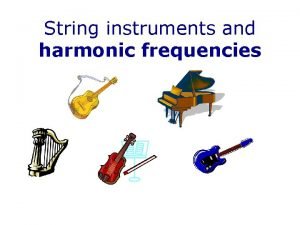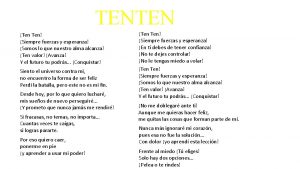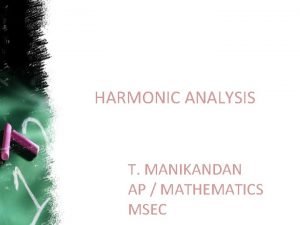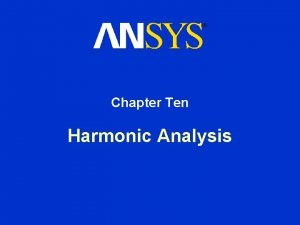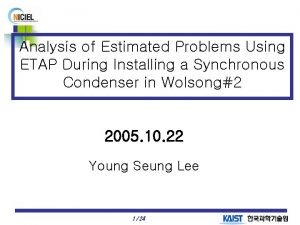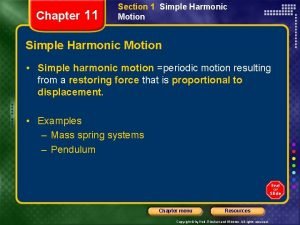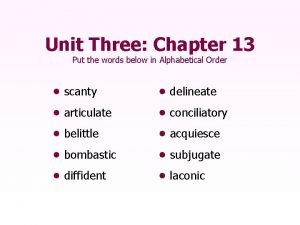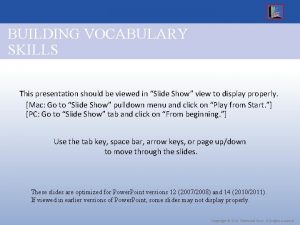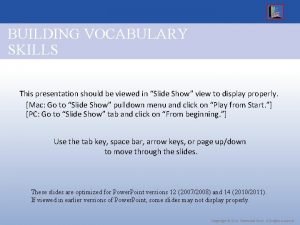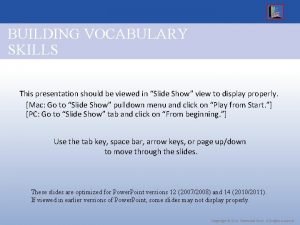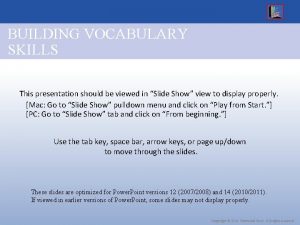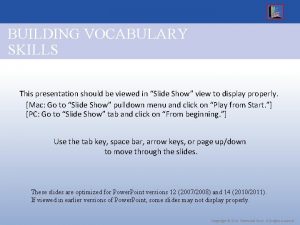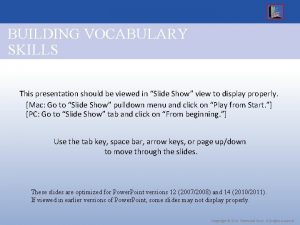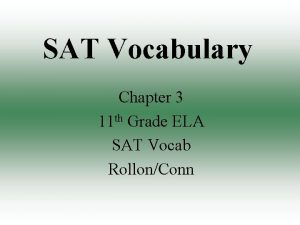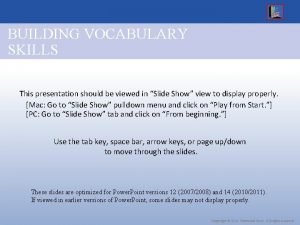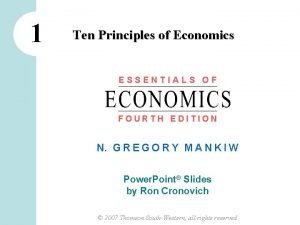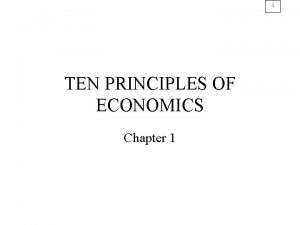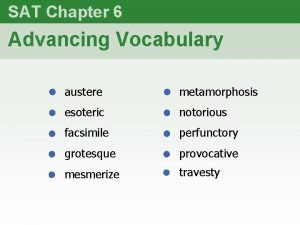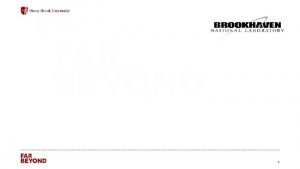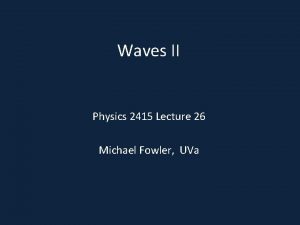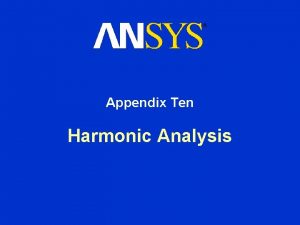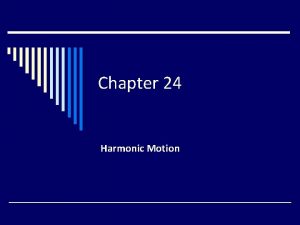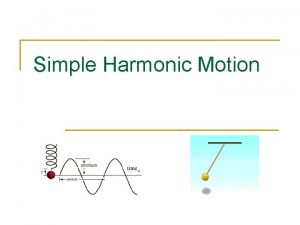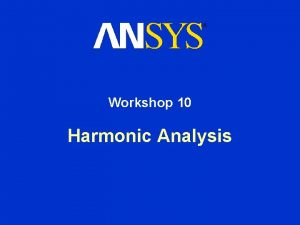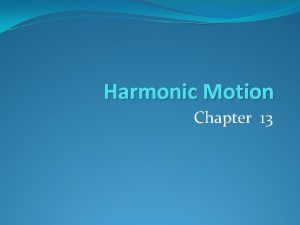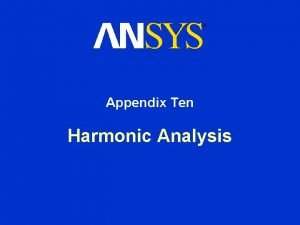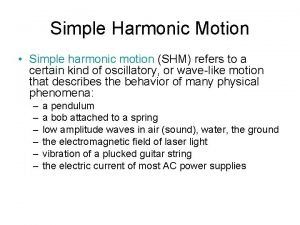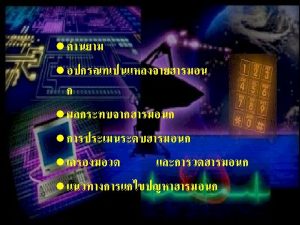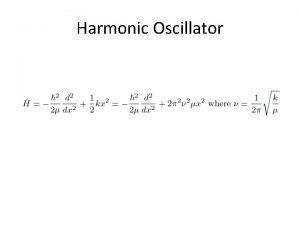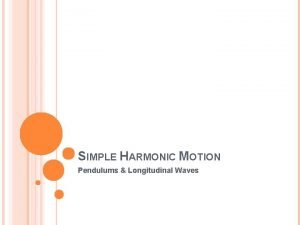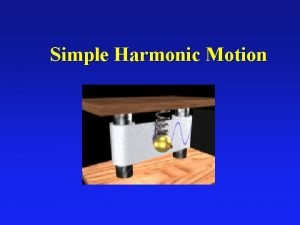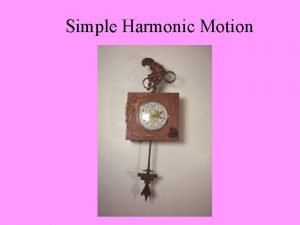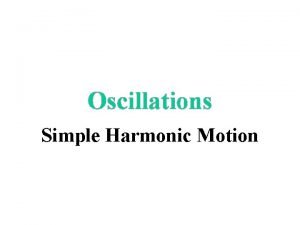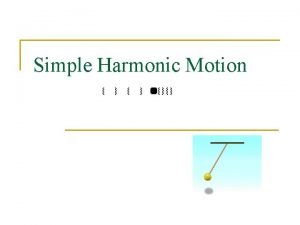Chapter Ten Harmonic Analysis Harmonic Analysis Chapter Overview








































- Slides: 40

Chapter Ten Harmonic Analysis

Harmonic Analysis Chapter Overview Training Manual – It is assumed that the user has already covered Chapter 4 Linear Static Structural Analysis and Chapter 5 Free Vibration Analysis prior to this chapter. • The following will be covered in this chapter: – Setting Up Harmonic Analyses – Harmonic Solution Methods – Damping – Reviewing Results ANSYS Workbench – Simulation • In this chapter, performing harmonic analyses in Simulation will be covered: • The capabilities described in this section are generally applicable to ANSYS Professional licenses and above. – Exceptions will be noted accordingly March 29, 2005 Inventory #002215 10 -2

Harmonic Analysis Background on Harmonic Analysis Training Manual – A harmonic, or frequency-response, analysis considers loading at one frequency only. Loads may be out-of-phase with one another, but the excitation is at a known frequency. This procedure is not used for an arbitrary transient load. – One should always run a free vibration analysis (Ch. 5) prior to a harmonic analysis to obtain an understanding of the dynamic characteristics of the model. • To better understand a harmonic analysis, the general equation of motion is provided first: ANSYS Workbench – Simulation • A harmonic analysis is used to determine the response of the structure under a steady-state sinusoidal (harmonic) loading at a given frequency. March 29, 2005 Inventory #002215 10 -3

Harmonic Analysis Background on Harmonic Analysis Training Manual – The use of complex notation is an efficient representation of the response. Since ej. A is simply (cos(A)+j sin(A)), this represents sinusoidal motion with a phase shift, which is present because of the imaginary (j= -1) term. – The excitation frequency W is the frequency at which the loading occurs. A force phase shift y may be present if different loads are excited at different phases, and a displacement phase shift f may exist if damping or a force phase shift is present. ANSYS Workbench – Simulation • In a harmonic analysis, the loading and response of the structure is assumed to be harmonic (cyclic): March 29, 2005 Inventory #002215 10 -4

Harmonic Analysis Background on Harmonic Analysis For example, consider the case on right where two forces are acting on the structure – Both forces are excited at the same frequency W, but “Force 2” lags “Force 1” by 45 degrees. This is a force phase shift y of 45 degrees. – The way in which this is represented is via complex notation. This, however, can be rewritten as: ANSYS Workbench – Simulation • Training Manual In this way, a real component F 1 and an imaginary component F 2 are used. – The response {x} is analogous to {F} Model shown is from a sample Solid. Works assembly. March 29, 2005 Inventory #002215 10 -5

Harmonic Analysis Basics of Harmonic Analysis Training Manual This results in the following assumptions: – [M], [C], and [K] are constant: • Linear elastic material behavior is assumed • Small deflection theory is used, and no nonlinearities included • Damping [C] should be included. Otherwise, if the excitation frequency W is the same as the natural frequency w of the structure, the response is infinite at resonance. • The loading {F} (and response {x}) is sinusoidal at a given frequency W, although a phase shift may be present • It is important to remember these assumptions related to performing harmonic analyses in Simulation. ANSYS Workbench – Simulation • For a harmonic analysis, the complex response {x 1} and {x 2} are solved for from the matrix equation: March 29, 2005 Inventory #002215 10 -6

Harmonic Analysis A. Harmonic Analysis Procedure Training Manual – Attach Geometry – Assign Material Properties – Define Contact Regions (if applicable) – Define Mesh Controls (optional) – Include Loads and Supports – Request Harmonic Tool Results – Set Harmonic Analysis Options – Solve the Model ANSYS Workbench – Simulation • The harmonic analysis procedure is very similar to performing a linear static analysis, so not all steps will be covered in detail. The steps in yellow italics are specific to harmonic analyses. – Review Results March 29, 2005 Inventory #002215 10 -7

Harmonic Analysis … Geometry Training Manual – Solid bodies, surface bodies, line bodies, and any combination thereof may be used – Recall that, for line bodies, stresses and strains are not available as output – A Point Mass may be present, although only acceleration loads affect a Point Mass ANSYS Workbench – Simulation • Any type of geometry may be present in a harmonic analysis March 29, 2005 Inventory #002215 10 -8

Harmonic Analysis … Material Properties Training Manual – All other material properties can be specified but are not used in a harmonic analysis – As will be shown later, damping is not specified as a material property but as a global property ANSYS Workbench – Simulation • In a harmonic analysis, Young’s Modulus, Poisson’s Ratio, and Mass Density are required input March 29, 2005 Inventory #002215 10 -9

Harmonic Analysis … Contact Regions Training Manual • The contact behavior is similar to free vibration analyses (Ch. 5), where nonlinear contact behavior will reduce to its linear counterparts since harmonic simulations are linear. – It is generally recommended, however, not to use a nonlinear contact type in a harmonic analysis ANSYS Workbench – Simulation • Contact regions are available in modal analysis. However, since this is a purely linear analysis, contact behavior will differ for the nonlinear contact types, as shown below: March 29, 2005 Inventory #002215 10 -10

Harmonic Analysis … Loads and Supports Training Manual – Thermal loads are not supported – Rotational Velocity is not supported – The Remote Force Load is not supported – The Pretension Bolt Load is nonlinear and cannot be used – The Compression Only Support is nonlinear and should not be used. If present, it behaves similar to a Frictionless Support • Remember that all structural loads will vary sinusoidally at the same excitation frequency ANSYS Workbench – Simulation • Structural loads and supports may also be used in harmonic analyses with the following exceptions: March 29, 2005 Inventory #002215 10 -11

Harmonic Analysis … Loads and Supports Training Manual – The “Solution Method” will be discussed in the next section. • It is useful to note at this point that ANSYS Professional does not support “Full” solution method, so it does not support a Given Displacement Support in a harmonic analysis. – Not all available loads support phase input. Accelerations, Bearing Load, and Moment Load will have a phase angle of 0°. ANSYS Workbench – Simulation • A list of supported loads are shown below: • If other loads are present, shift the phase angle of other loads, such that the Acceleration, Bearing, and Moment Loads will remain at a phase angle of 0°. March 29, 2005 Inventory #002215 10 -12

Harmonic Analysis … Loads and Supports Training Manual – Add any of the supported loads as usual. – Under “Time Type, ” change it from “Static” to “Harmonic” – Enter the magnitude (or components, if available) – Phase input, if available, can be input • If only real F 1 and imaginary F 2 components of the load are known, the magnitude and phase y can be calculated as follows: ANSYS Workbench – Simulation • To add a harmonic load: March 29, 2005 Inventory #002215 10 -13

Harmonic Analysis … Loads and Supports Training Manual – The magnitude and phase angle will be accounted for in this visual representation of the loading ANSYS Workbench – Simulation • The loading for two cycles may be visualized by selecting the load, then clicking on the “Worksheet” tab March 29, 2005 Inventory #002215 10 -14

Harmonic Analysis B. Solving Harmonic Analyses – Select the Solution branch and insert a Harmonic Tool from the Context toolbar – In the Details view of the Harmonic Tool, one can enter the Minimum and Maximum excitation frequency range and Solution Intervals • The frequency range fmax-fmin and number of intervals n determine the freq interval DW • Simulation will solve n frequencies, starting from W+DW. In the example above, with a frequency range of 0 – 10, 000 Hz at 10 intervals, this means that Simulation will solve for 10 excitation frequencies of 1000, 2000, 3000, 4000, 5000, 6000, 7000, 8000, 9000, and 10000 Hz. ANSYS Workbench – Simulation • Prior to solving, request the Harmonic Tool: Training Manual March 29, 2005 Inventory #002215 10 -15

Harmonic Analysis … Solution Methods Training Manual – The Mode Superposition method is the default solution option and is available for ANSYS Professional and above – The Full method is available for ANSYS Structural and above • Under the Details view of the Harmonic Tool, the “Solution Method” can be toggled between the two options (if available). • The Details view of the Solution branch should not be used, as it has no effect on the analysis. ANSYS Workbench – Simulation • There are two solution methods available in ANSYS Structural and above. Both methods have their advantages and shortcomings, so these will be discussed next: March 29, 2005 Inventory #002215 10 -16

Harmonic Analysis … Mode Superposition Method Training Manual – Recall that the equation for harmonic analysis is as follows: – For linear systems, one can express the displacements x as a linear combination of mode shapes fi : where yi are modal coordinates (coefficient) for this relation. • For example, one can perform a modal analysis to determine the natural frequencies wi and corresponding mode shapes fi. ANSYS Workbench – Simulation • The Mode Superposition method solves the harmonic equation in modal coordinates • One can see that as more modes n are included, the approximation for {x} becomes more accurate. March 29, 2005 Inventory #002215 10 -17

Harmonic Analysis … Mode Superposition Method Training Manual 1. Because of the fact that modal coordinates are used, a harmonic solution using the Mode Superposition method will automatically perform a modal analysis first – Simulation will automatically determine the number of modes n necessary for an accurate solution – Although a free vibration analysis is performed first, the harmonic analysis portion is very quick and efficient. Hence, the Mode Superposition method is usually much faster overall than the Full method. ANSYS Workbench – Simulation • The preceding discussion is meant to provide background information about the Mode Superposition method. From this, there are three important points to remember: March 29, 2005 Inventory #002215 10 -18

Harmonic Analysis … Mode Superposition Method Training Manual – In a harmonic analysis, the peak response will correspond with the natural frequencies of the structure. Since the natural frequencies are known, Simulation can cluster the results near the natural frequencies instead of using evenly spaced results. In this example, the cluster option captures the peak response better than evenly-spaced intervals (4. 51 e-3 vs. 4. 30 e-3) The Cluster Number determines how many results on either side of a natural frequency is solved. ANSYS Workbench – Simulation 2. Since a free vibration analysis is performed, Simulation will know what the natural frequencies of the structure are March 29, 2005 Inventory #002215 10 -19

Harmonic Analysis … Mode Superposition Method Training Manual – Nonzero prescribed displacements are not possible because the solution is done with modal coordinates – This was mentioned earlier during the discussion on loads and supports ANSYS Workbench – Simulation 3. Due to the nature of the Mode Superposition method, Given Displacement Supports are not allowed March 29, 2005 Inventory #002215 10 -20

Harmonic Analysis … Full Method Training Manual – Recall the harmonic analysis equation: – In the Full method, this matrix equation is solved for directly in nodal coordinates, analogous to a linear static analysis except that complex numbers are used: ANSYS Workbench – Simulation • The Full method is an alternate way of solving harmonic analyses March 29, 2005 Inventory #002215 10 -21

Harmonic Analysis … Full Method Training Manual 1. For each frequency, the Full method must factorize [Kc]. – In the Mode Superposition method, a simpler set of uncoupled equations is solved for. In the Full method, a more complex, coupled matrix [KC] must be factorized. – Because of this, the Full method tends to be more computationally expensive than the Mode Superposition method 2. Given Displacement Support is available – Because {x} is solved for directly, imposed displacements are permitted. This allows for the use of Given Displacement Supports. ANSYS Workbench – Simulation • This results in several differences compared with the Mode Superposition method: March 29, 2005 Inventory #002215 10 -22

Harmonic Analysis … Full Method Training Manual – Unlike the Mode Superposition method, the Full method does not rely on mode shapes and natural frequencies – No free vibration analysis is internally performed – The solution of {x. C} is exact • No approximation of the response {x} to mode shapes is used – However, because modal information is not present to Simulation during a solution, no clustering of results is possible. Only evenly-spaced intervals is permitted. ANSYS Workbench – Simulation 3. The Full method does not use modal information March 29, 2005 Inventory #002215 10 -23

Harmonic Analysis C. Damping Input Training Manual – It was noted earlier that damping is specified as a global property – For ANSYS Professional license, only a constant damping ratio x is available for input – For ANSYS Structural licenses and above, either a constant damping ratio x or beta damping value can be input • Note that if both constant damping and beta damping are input, the effects will be cumulative • Either damping option can be used with either solution method (full or mode superposition) ANSYS Workbench – Simulation • The harmonic equation has a damping matrix [C] March 29, 2005 Inventory #002215 10 -24

Harmonic Analysis … Background on Damping Training Manual – The effect damping has on the response is to shift the natural frequencies and to lower the peak response – Damping is present in many forms in any structural system • Damping is a complex phenomena due to various effects. The mathematical representation of damping, however, is quite simple. Viscous damping will be considered here: – The viscous damping force Fdamp is proportional to velocity where c is the damping constant – There is a value of c called critical damping ccr where no oscillations will take place ANSYS Workbench – Simulation • Damping results in energy loss in a dynamic system. – The damping ratio x is the ratio of actual damping c over critical damping ccr. March 29, 2005 Inventory #002215 10 -25

Harmonic Analysis … Constant Damping Ratio Training Manual – The value of x will be used directly in Mode Superposition method – The constant damping ratio x is unitless – In the Full method, the damping ratio x is not directly used. This will be converted internally to an appropriate value for [C] ANSYS Workbench – Simulation • The constant damping ratio input in Simulation means that the value of x will be constant over the entire frequency range. March 29, 2005 Inventory #002215 10 -26

Harmonic Analysis … Beta Damping Training Manual • This is related back to the damping ratio x: One can see from this equation that, with beta damping, the effect of damping increases linearly with frequency – Unlike the constant damping ratio, beta damping increases with increasing frequency – Beta damping tends to damp out the effect of higher frequencies ANSYS Workbench – Simulation • Another way to model damping is to assume that damping value c is proportional to the stiffness k by a constant b: – Beta damping is in units of time March 29, 2005 Inventory #002215 10 -27

Harmonic Analysis … Beta Damping Training Manual – Beta damping value can be directly input – A damping ratio and frequency can be input, and the corresponding beta damping value will be calculated by Simulation, per the equation on the previous slide Although a frequency and damping ratio is input in this second case, remember that beta damping will linearly increase with frequency. This means that lower frequencies will have less damping and higher frequencies will experience more damping. ANSYS Workbench – Simulation • There are two methods of input of beta damping: March 29, 2005 Inventory #002215 10 -28

Harmonic Analysis … Damping Relationships Training Manual – The quality factor Qi is 1/(2 xi) – The loss factor hi is the inverse of Q or 2 xi – The logarithmic decrement di can be approximated for light damping cases as 2 pxi – The half-power bandwidth Dwi can be approximated for lightly damped structures as 2 wixi • Remember that these measures of damping are simplified and for single DOF systems. ANSYS Workbench – Simulation • There are some other measures of damping commonly used. Note that these are usually for single degree of freedom systems, so extrapolating it for use in multi-DOF systems (such as FEA) should be done with caution! – If the user understands the physical structure’s response over a frequency range as well as the difference between constant damping ratio and beta damping, then damping can be March 29, 2005 modeled appropriately in Simulation Inventory #002215 10 -29

Harmonic Analysis D. Request Harmonic Tool Results Training Manual – Three types of results are available: • Contour results of components of stresses, strains, or displacements for surfaces, parts, and/or assemblies at a specified frequency and phase angle • Frequency response plots of minimum, maximum, or average components of stresses, strains, displacements, or acceleration at selected vertices, edges, or surfaces. • Phase response plots of minimum, maximum, or average components of stresses, strains, or displacements at a specified frequency – Unlike a linear static analysis, results must be requested before initiating a solution. Otherwise, if other results are requested after a solution is completed, another solution must be re-run. ANSYS Workbench – Simulation • Results can then be requested from Harmonic Tool branch: March 29, 2005 Inventory #002215 10 -30

Harmonic Analysis … Request Harmonic Tool Results Training Manual – Be sure to scope results on entities of interest – For edges and surfaces, specify whether average, minimum, or maximum value will be reported – Enter any other applicable input • If results are requested between solved-for frequency ranges, linear interpolation will be used to calculate the response – For example, if Simulation solves frequencies from 100 to 1000 Hz at 100 Hz intervals, and the user requests a result for 333 Hz, this will be linearly interpolated from results at 300 and 400 Hz. ANSYS Workbench – Simulation • Request any of the available results under the Harmonic Tool branch March 29, 2005 Inventory #002215 10 -31

Harmonic Analysis … Request Harmonic Tool Results Training Manual – Derived quantities such as equivalent/principal stresses or total deformation may not be harmonic if the components are not in-phase, so these results are not available. • No Convergence is available on Harmonic results – Perform a modal analysis and perform convergence on mode shapes which will reflect response. This will help to ensure that the mesh is fine enough to capture the dynamic response in a subsequent harmonic analysis. ANSYS Workbench – Simulation • Simulation assumes that the response is harmonic (sinusoidal). March 29, 2005 Inventory #002215 10 -32

Harmonic Analysis … Solving the Model Training Manual – Only informative status of the type of analysis to be solved will be displayed • After Harmonic Analysis options have been set and results have been requested, the solution can be solved as usual with the Solve button ANSYS Workbench – Simulation • The Details view of the Solution branch is not used in a Harmonic analysis. March 29, 2005 Inventory #002215 10 -33

Harmonic Analysis … Contour Results Training Manual ANSYS Workbench – Simulation • Contour results of components of stress, strain, or displacement are available at a given frequency and phase angle March 29, 2005 Inventory #002215 10 -34

Harmonic Analysis … Contour Animations ANSYS Workbench – Simulation • These results can be animated. Animations will use the actual harmonic response (real and imaginary results) Training Manual March 29, 2005 Inventory #002215 10 -35

Harmonic Analysis … Frequency Response Plots Training Manual For scoped results, average, minimum, or maximum values can be requested. Bode plots (shown on right) is the default display method. However, real and imaginary results can also be plotted. The Ctrl-left mouse button allows the user to query results on the graph. Results can also be exported to Excel by right-clicking on the branch Left-click on the graphics window to change the Graph Properties ANSYS Workbench – Simulation • XY Plots of components of stress, strain, displacement, or acceleration can be requested March 29, 2005 Inventory #002215 10 -36

Harmonic Analysis … Phase Response Plots Training Manual The average, minimum, or maximum value of the scoped results can be used to track the phase relationship with all of the input forces. In this example, the response is lagging the input forces, as expected, and the user can visually examine this phase difference. Left-click on the graphics window to change the Graph Properties ANSYS Workbench – Simulation • Comparison of phase of components of stress, strain, or displacement with input forces can be plotted at a given frequency March 29, 2005 Inventory #002215 10 -37

Harmonic Analysis … Requesting Results Training Manual – A free vibration analysis using the Frequency Finder should always be performed first to determine the natural frequencies and mode shapes • Although a free vibration analysis is internally performed with the Mode Superposition method, the mode shapes are not available to the user to review. Hence, a separate Environment branch must be inserted or duplicated to add the Frequency Finder tool. – Oftentimes, two harmonic solutions may need to be run: • A harmonic sweep of the frequency range can be performed initially, where displacements, stresses, etc. can be requested. This allows the user to see the results over the entire frequency range of interest. • After the frequencies and phases at which the peak response(s) occur are determined, contour results can be requested to see the overall response of the structure at these frequencies. ANSYS Workbench – Simulation • A harmonic solution usually requires multiple solutions: March 29, 2005 Inventory #002215 10 -38

Harmonic Analysis E. Workshop 10 • Goal: – Explore the harmonic response of the machine frame (Frame. x_t) shown here. The frequency response as well as stress and deformation at a specific frequency will be determined. ANSYS Workbench – Simulation • Workshop 10 – Harmonic Analysis Training Manual March 29, 2005 Inventory #002215 10 -39

March 29, 2005 Inventory #002215 10 -40
 First harmonic and second harmonic
First harmonic and second harmonic It's twenty to ten.
It's twenty to ten. Ten ten siempre fuerzas y esperanza
Ten ten siempre fuerzas y esperanza Amia 10 x 10
Amia 10 x 10 Chapter 1 overview of financial statement analysis
Chapter 1 overview of financial statement analysis In harmonic analysis the term a1cosx+b1sinx is called
In harmonic analysis the term a1cosx+b1sinx is called Harmonic analysis ansys
Harmonic analysis ansys Etap harmonic analysis
Etap harmonic analysis Simple harmonic motion chapter 11
Simple harmonic motion chapter 11 Emt chapter 24 trauma overview
Emt chapter 24 trauma overview Emt chapter 14 medical overview
Emt chapter 14 medical overview Chapter 9 lesson 2 photosynthesis an overview
Chapter 9 lesson 2 photosynthesis an overview Chapter 12 selling overview
Chapter 12 selling overview Chapter 2 an overview of the financial system
Chapter 2 an overview of the financial system Chapter 1 overview of verb tenses
Chapter 1 overview of verb tenses Overview of personal finance chapter 1
Overview of personal finance chapter 1 Overview of the dentitions chapter 11
Overview of the dentitions chapter 11 Chapter 1 review personal finance
Chapter 1 review personal finance General features of animals
General features of animals Chapter 1 an overview of financial management
Chapter 1 an overview of financial management Elements and their properties section 1 metals
Elements and their properties section 1 metals Put the words below in alphabetical order
Put the words below in alphabetical order Complete the definitions with the words below
Complete the definitions with the words below What are the essentials of a successful ffa chapter
What are the essentials of a successful ffa chapter Chapter 16 ten words in context
Chapter 16 ten words in context Chapter 13 ten words in context sentence check 2 answers
Chapter 13 ten words in context sentence check 2 answers Chapter 25 ten words in context
Chapter 25 ten words in context Sentence check 2 chapter 4
Sentence check 2 chapter 4 Sentence check 2 chapter 12
Sentence check 2 chapter 12 Ten words in context chapter 10
Ten words in context chapter 10 Sentence check 1 chapter 3
Sentence check 1 chapter 3 Ten words in context chapter 2
Ten words in context chapter 2 One of the ten principles of economics in chapter 1
One of the ten principles of economics in chapter 1 Chapter 6 sentence check 1
Chapter 6 sentence check 1 Aim chapter 7
Aim chapter 7 One of the ten principles of economics in chapter 1
One of the ten principles of economics in chapter 1 Ten principles of economics chapter 1
Ten principles of economics chapter 1 Chapter 18 adjustments and the ten-column worksheet answers
Chapter 18 adjustments and the ten-column worksheet answers Chapter 6 ten words in context
Chapter 6 ten words in context What are the ten essentials of a successful ffa chapter
What are the ten essentials of a successful ffa chapter Harmonic waves
Harmonic waves
